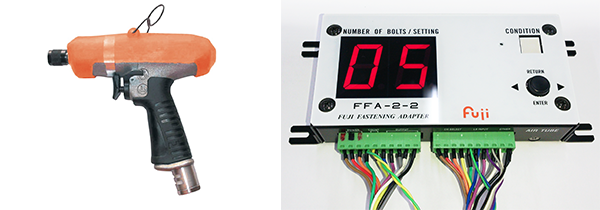Are Pulse Tools right for your application?
 5 things to know when considering pulse Tools for an application
5 things to know when considering pulse Tools for an application
Choosing the right tool for an application is important for the productivity and quality of an assembly operation. Pulse tools have some very attractive characteristics such as high run down speed, power-to-weight ratio as well as no reaction force but they are not always the best choice. Below are some considerations to keep in mind when considering pulse tools for an application.
1. How soft is the joint?
Joints can be classified on a scale from hard to soft.
- “Hard” meaning that they have little rotation from the point where the bolt is in contact with the surface to final torque. If a joint is very hard (<30deg) then it may suffer from increased torque scatter due to shut off after only one or a couple of pulses. The first pulses contribute with larger installed torque increases.
- “Soft” meaning a large angle of rotation to final torque. A very soft joint results in many pulses to reach target which usually means lower torque scatter but at the same time, more wear to the tool. In more extreme cases involving soft gaskets or seals, the bolt may rotate more than 360 degrees from the snug point and require 50 pulses or more to complete.
Pulse tools give their best performance on medium-hard applications. For Fuji FLT tools the “sweet spot” is around 100 degrees of rotation from the snug point.
2. What is the torque target?
Normally a joint with high-quality standards, justifying the use of pulse tools, have a specified torque target. This is a key guidance in selecting a tool, but this is not enough. As detailed in part one of this guide, the available air pressure has an effect on the torque that the tool can deliver; as well, the hardness of the joint, as described above, is also an important factor.
- On a soft joint, it is sometimes beneficial to step up to a larger tool to reduce the number of pulses needed to reach the target torque, thereby reducing tightening time and tool wear. While we do not recommend pulse tools on very soft joints, should the circumstances require it – oversizing the tool should be the first thing to try.
- On hard joints reducing the air pressure is normally the best way to increase the number of pulses and achieve a more stable torque.
Normally a Fuji pulse tool operates best and is optimized between 60-80% of its maximum torque range as far as the number of pulses, accuracy and wear is concerned. However, depending on the available pressure and joint hardness, this reference has to be adjusted. The number of pulses that are optimal for a tightening differs depending on how the pulse unit is constructed and the specific application at hand. For the Fuji shut-off tool, the FLT, 10-15 pulses to shut-off is optimal and between 5 and 25 is an acceptable range.
3. What are the accuracy demands?
Similar to a specified torque target, a quality critical application normally has a maximum allowed torque scatter. This is a very important number in judging if a pulse tool is suitable for the application. The accuracy demands are usually either expressed in the same torque unit as the torque target or by a percentage value. Accuracy specifications for pulse tools vary between manufacturers and there is no ratified standard that defines a single way to measure pulse tools accuracy.
For Fuji pulse tools we use the ISO/TS 17104 technical specification that is a suggestion put forward by a working group but not yet adopted as an ISO standard. Basically this ISO/TS 17104 strives to test the tool under multiple circumstances (soft and hard joint) to give an accuracy number that should be generally applicable in the field. The Fuji FLT tools test to ±20% over 6σ or better under this standard which means that 99.7% of performance results are within this tolerance. This may seem like a large scatter, but the test is producing a “worst case scenario” and the tools should be able to handle any application within these accuracy demands. On applications that are close to the “sweet spot” of 100deg of rotation and have low joint variation, it is not uncommon to see scatter lower than ±5%. On prepared test rigs, tool manufacturer can reach even lower values.
It is important to note that while non shut-off pulse tools can produce stable torque output, they are operator dependent as there is no mechanical shut off mechanism ensuring shut off at the same level every time.
4. Is the joint accessible?
Making sure the operator can access the joint easily is vital to a well-planned working station. The first thing to consider is the orientation of the bolt. Generally, if the tightening is vertical a straight pulse tool may be a better choice. From an ergonomic point of view, the wrist angle of the operator is a key factor and having a set up that enables the operator to keep his or her wrist straight is a clear benefit. One of the key benefits of a pulse tool is the high power-to-weight ratio and lack of reaction forces which enables it to be easily applied, whereas using a direct driven tool would require assist arms or reaction devices.
As detailed in part one of this series, with pulse tools we always strive to have a short distance between the tool anvil and the joint. Long sockets are the enemy of a stable torque and a long tool lifespan.
There are other elements to consider here, not directly related to tool selection, like tool holders, suspension and routing of hoses to provide the optimal working environment.
5. Does the application require a shut-off tool?
This choice will be done primarily on the level of error proofing needed. A non-shut-off tool is normally used on applications that are less critical or applications that will have more operations done to them (usually final torqueing with a click wrench). Shut-off tools provide a tightening not influenced by the operator and can replace the need for click wrenches on some applications, or provide a higher level of stability on others.
Also, bolt counting can be achieved with shut-off tools by connecting the tool exhaust to a pressure switch. Fuji has a countdown adapter called the FFA-2-2 and specifically for this purpose. The bolt counting solutions can be used to ensure all tightening have been carried out in a multi-bolt application.

To summarize the above considerations based on the application at hand:
| What to consider: | Recommendation: |
|---|---|
| How soft is the joint? |
|
| What is the torque target? |
|
| What are the accuracy demands? |
|
| Is the joint accessible? |
|
| Does the application require shut-off Tools? |
|